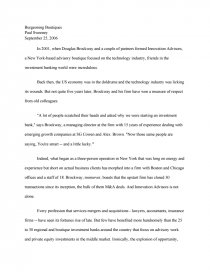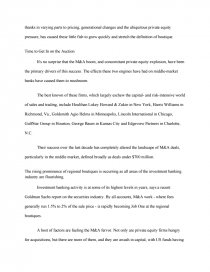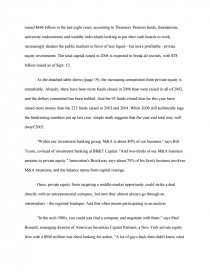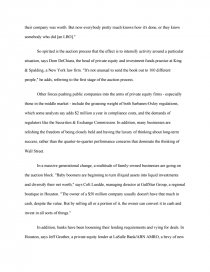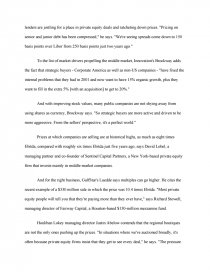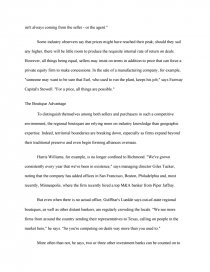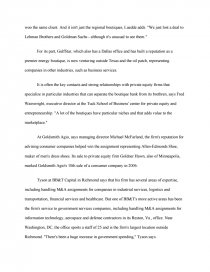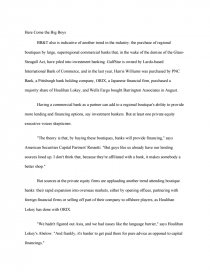Boutique Investment Banks
Essay by 24 • December 9, 2010 • 2,243 Words (9 Pages) • 1,745 Views
Burgeoning Boutiques
Paul Sweeney
September 25, 2006
In 2001, when Douglas Brockway and a couple of partners formed Innovation Advisors, a New York-based advisory boutique focused on the technology industry, friends in the investment banking world were incredulous.
Back then, the US economy was in the doldrums and the technology industry was licking its wounds. But not quite five years later, Brockway and his firm have won a measure of respect from old colleagues.
"A lot of people scratched their heads and asked why we were starting an investment bank," says Brockway, a managing director at the firm with 15 years of experience dealing with emerging growth companies at SG Cowen and Alex. Brown. "Now those same people are saying, You're smart -- and a little lucky.'"
Indeed, what began as a three-person operation in New York that was long on energy and experience but short on actual business clients has morphed into a firm with Boston and Chicago offices and a staff of 18. Brockway, moreover, boasts that the upstart firm has closed 30 transactions since its inception, the bulk of them M&A deals. And Innovation Advisors is not alone.
Every profession that services mergers and acquisitions - lawyers, accountants, insurance firms -- have seen its fortunes rise of late. But few have benefited more handsomely than the 25 to 30 regional and boutique investment banks around the country that focus on advisory work and private equity investments in the middle market. Ironically, the explosion of opportunity, thanks in varying parts to pricing, generational changes and the ubiquitous private equity pressure, has caused these little fish to grow quickly and stretch the definition of boutique.
Time to Get In on the Auction
It's no surprise that the M&A boom, and concomitant private equity explosion, have been the primary drivers of this success. The effects these two engines have had on middle-market banks have caused them to mushroom.
The best known of these firms, which largely eschew the capital- and risk-intensive world of sales and trading, include Houlihan Lokey Howard & Zukin in New York, Harris Williams in Richmond, Va., Goldsmith Agio Helms in Minneapolis, Lincoln International in Chicago, GulfStar Group in Houston, George Baum in Kansas City and Edgeview Partners in Charlotte, N.C.
Their success over the last decade has completely altered the landscape of M&A deals, particularly in the middle market, defined broadly as deals under $700 million.
The rising prominence of regional boutiques is occurring as all areas of the investment banking industry are flourishing.
Investment banking activity is at some of its highest levels in years, says a recent Goldman Sachs report on the securities industry. By all accounts, M&A work - where fees generally run 1.5% to 2% of the sale price - is rapidly becoming Job One at the regional boutiques.
A host of factors are fueling the M&A fervor. Not only are private equity firms hungry for acquisitions, but there are more of them, and they are awash in capital, with US funds having raised $446 billion in the last eight years, according to Thomson. Pension funds, foundations, university endowments and wealthy individuals looking to put their cash hoards to work, increasingly disdain the public markets in favor of less liquid - but more profitable - private equity investments. The total capital raised in 2006 is expected to break all records, with $78 billion raised as of Sept. 12.
As the attached table shows (page 19), the increasing competition from private equity is remarkable. Already, there have been more funds closed in 2006 than were raised in all of 2002, and the dollars committed has been trebled. And the 92 funds closed thus far this year have raised more money than the 225 funds raised in 2003 and 2004. While 2006 still technically lags the fundraising numbers put up last year, simple math suggests that the year-end total may well dwarf 2005.
"Within our investment banking group, M&A is about 80% of our business," says Bill Tyson, co-head of investment banking at BB&T Capital. "And two-thirds of our M&A business pertains to private equity." Innovation's Brockway says about 70% of his firm's business involves M&A situations, and the balance stems from capital raisings.
Once, private equity firms targeting a middle-market opportunity could strike a deal directly with an entrepreneurial company, but now they almost always go through an intermediary - the regional boutique. And that often means participating in an auction.
"In the mid-1980s, you could just find a company and negotiate with them," says Paul Rossetti, managing director of American Securities Capital Partners, a New York private equity firm with a $900 million war chest looking for action. "A lot of guys back then didn't know what their company was worth. But now everybody pretty much knows how it's done, or they know somebody who did [an LBO]."
So spirited is the auction process that the effect is to intensify activity around a particular situation, says Dom DeChiara, the head of private equity and investment funds practice at King & Spalding, a New York law firm. "It's not unusual to send the book out to 100 different people," he adds, referring to the first stage of the auction process.
Other forces pushing public companies into the arms of private equity firms - especially those in the middle market - include the groaning weight of both Sarbanes-Oxley regulations, which some analysts say adds $2 million a year in compliance costs, and the demands of regulators like the Securities & Exchange Commission. In addition, many businesses are relishing the freedom of being closely held and having the luxury of thinking about long-term success, rather than the quarter-to-quarter performance concerns that dominate the thinking of Wall Street.
In a massive generational change, a multitude of family-owned businesses are going on the auction block. "Baby boomers are beginning to turn illiquid assets into liquid investments and diversify their net worth," says Colt Luedde, managing director at GulfStar Group, a regional boutique in Houston. "The owner of a $50 million company usually doesn't have that much in cash, despite the value. But by selling all or a portion of it, the owner can convert it to cash and invest
...
...
